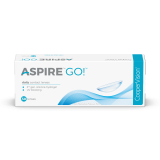To help us feel comfortable throughout our day, we blink automatically. This helps lubricate and moisten our eyes, so they don’t feel dry. If you’ve experienced hot, dry winds blowing into your face, you know that unpleasant “sandpaper eyes” feeling.
With some of us however, that feeling of dry, irritated eyes stays with us. Sometimes the eyes don’t produce enough tears to moisten our eyes and those tears don’t drain properly. This condition is common when we get older. Eye doctors refer to it as “keratoconjunctivitis sicca,” but you probably know it by another name..."Dry Eye Syndrome."
Dry Eye Syndrome symptoms
Dry Eye Syndrome, or simply “DES,” affects people over the age of 40. Some symptoms include:
- Itchy eyes
- Red, bloodshot eyes
- An increased sensitivity to light
If you think, “Hey, that’s how I felt last week,” think back to what you were doing. We’ve all had red, dry eyes at some point. Were you in a hot, windy environment? What about an office with air constantly blowing onto your face, or you find yourself staring at a computer or TV screen for a long time?
A constant breeze can dry out our eyes and staring intently at monitors can cause us to not blink as often as we should; when this happens, we don’t receive the moisture our eyes need.
If you weren’t trekking across the Sahara Desert (or at least watching a long movie about it on your television), and you’re finding that your eyes feel dry more often than they used to, then you may have dry eyes.
Dry Eye Syndrome treatment
While common, Dry Eye Syndrome isn’t something you’ll simply “get over,” like the common cold. Your eye doctor will prescribe treatment for you that you’ll need to stick with to really help alleviate the condition.
These treatments may include:
Applying eye drops - If your eyes are chronically dry, then applying moisture by using artificial tears throughout your day may help. Note that our tears are more than just water. They also contain other ingredients that help fight infection and lubricate the eye, so that it stays moist.
Don’t think splashing water in your face will do the trick. It won’t.
Ointments and other medications - If you need a little help getting those tears to start flowing, prescription medications are available that may help. Ask your eye doctor.
Surgery - With surgery for Dry Eye Syndrome, the ducts that allow our tears to drain can be closed. Why do such a thing? Because it can help keep more tears around the eyes, and thus help them stay moist, too.
While there isn’t one method for alleviating dry eyes for everyone, the methods we’ve listed here have helped others with this problem. Consult with your optometrist or ophthalmologist if these treatments may be right for you.






